Ex Corpore: A Study for Five Figures
I
‘From childhood’s hour I have not been / As others were – I have not seen / As other’s saw.’ – Edgar Allan Poe
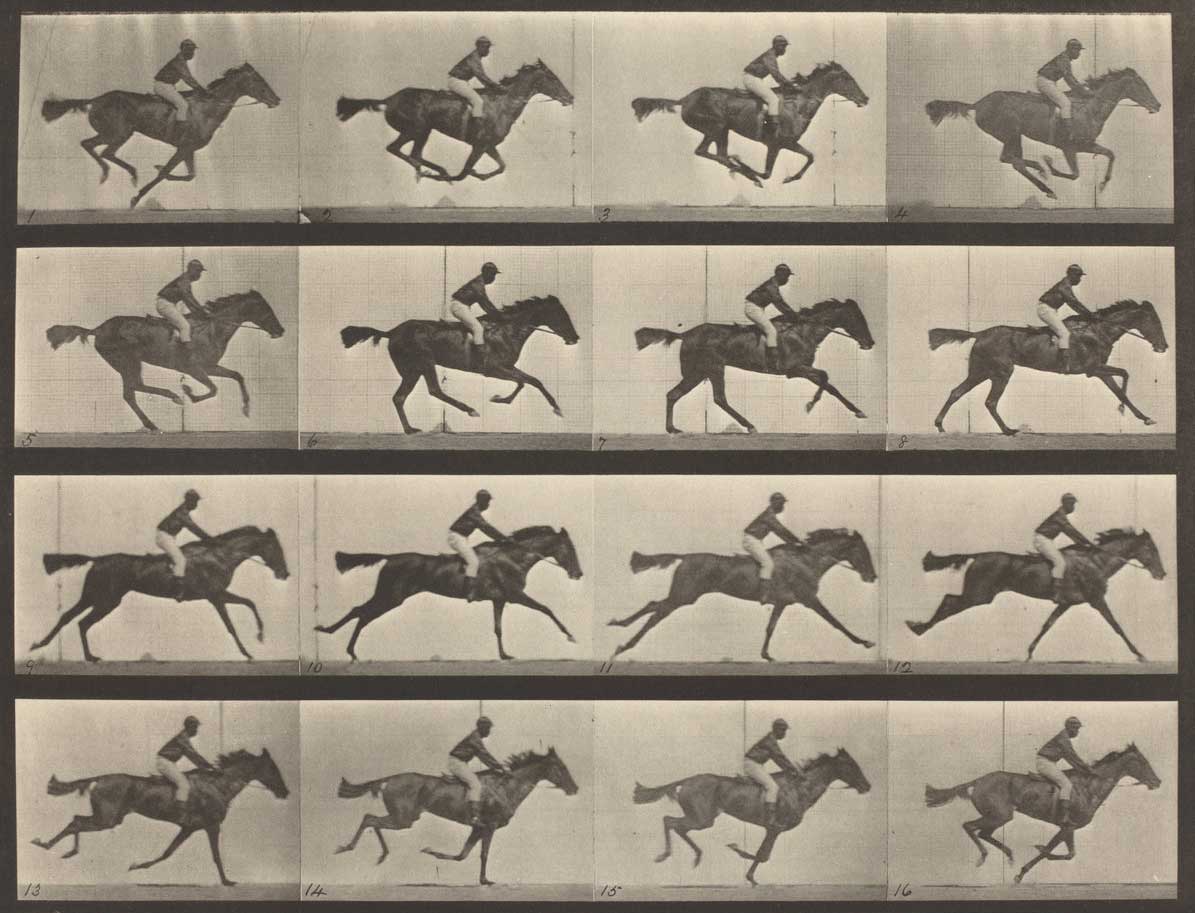
In 1874, in the Wild West, a man leaves a San Francisco parlour, catches the Vallejo ferry, a train, then finally takes a horse and cart to Yellow Jacket Mine, completing a journey of seventy-five miles to interrupt a card game. ‘My name is Muybridge and I have a message for you from my wife,’ he says, and pulls the trigger of his revolver. The man, Eadweard Muybridge, who had photographed a horse two years previously, and in doing so invented the essentials of motion-picture technology; the motive for the shooting, revenge for adultery.1
As Rebecca Solnit says, ‘the Victorian age had launched a juggernaut, and slowing down was the single thing hardest to do. This was the paradox of Muybridge’s work. He was using state-of-the-art equipment to feed that ravenous appetite for place, for time, for bodies […] With the motion studies that resulted it was as though he were returning bodies themselves to those who craved them – not bodies as they might be daily experienced, bodies as sensations of gravity, fatigue, strength pleasure, but bodies become weightless images, bodies dissected and reconstructed by light and machine and fantasy.’
Previously, Muybridge operated on borderlines – photographing Yosemite National Park, Point Reese lighthouse in California – preoccupied as he was with precipices, peripheral zones and abyss-edges.3
In the new world of where there is an image of everything and everything is an image, Muybridge was careful of projecting a particular image of himself, constantly the showman, always creating narratives for his audiences, and reinventing himself as he saw fit.
Muybridge, a ‘man who had spent his life photographing somewhere… was going to give the rest of his life over to nowhere, the neutralised places in which he he could match the machine speed of photography to the cadences of bodily movement. He had ‘given up place without motion for motion without place, and mountain ranges had been replaced by a gridded white wall, a grid within a grid,4 the one behind the figures in motion.’5
II
‘The body is almost an obstacle.’ – Marina Abramović
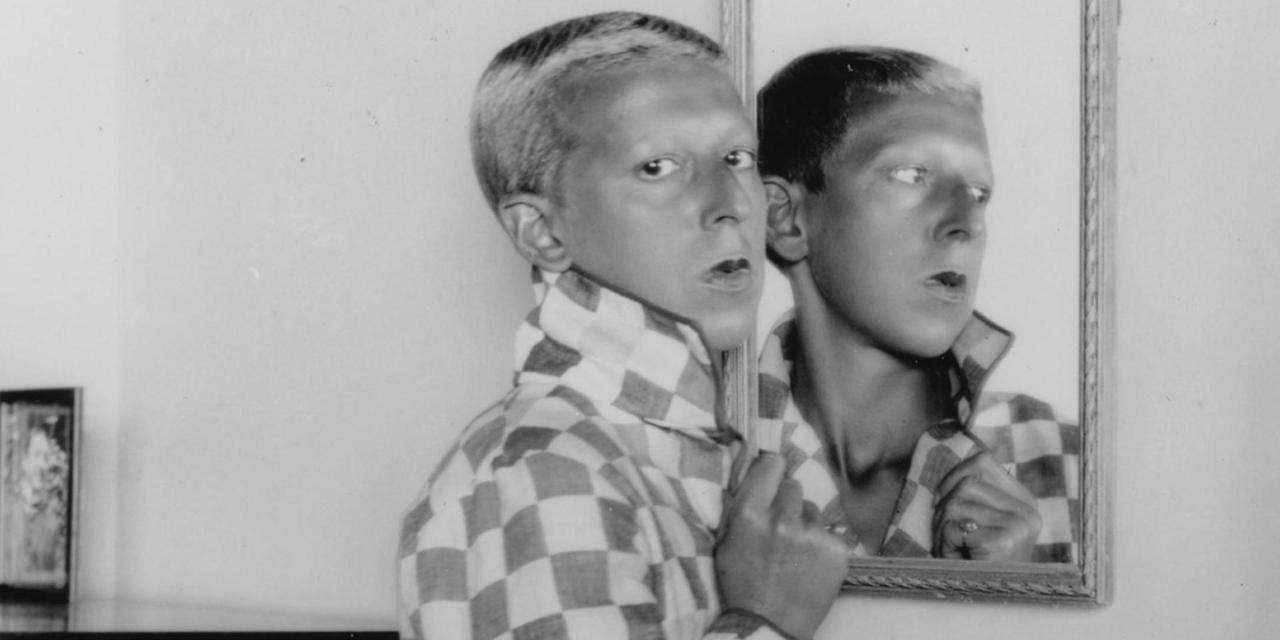
‘Photography is a kind of primitive theatre, a kind of tableau vivant,’ as Barthes wrote in Camera Lucida, and no-one embodies this more than Surrealist writer, artist, performer, propagandist, and saboteur Claude Cahun. Born Lucy Schwob, Cahun was the niece of fin de siècle symbolist writer Marcel Schwob. Moving to Paris in the early ’20s with her step-sister and lover Suzanne Malherbe (Malherbe worked as a graphic artist under the pseudonym Marcel Moore), Cahun developed associations with Bataille and Breton. Intellectually marginalised as a lesbian and Jewish woman, Cahun transformed – and transcended – herself: ‘It’s not without an ulterior motive I have my hair shaved off, my teeth pulled, my breasts, everything that gets in the way or irritates my gaze, stomach, ovaries, the conscious cyst-like brain.’6
Though seen a predecessor to Cindy Sherman, Cahun was better known during her lifetime as a writer than a photographer (she only published one self-portrait during her lifetime) – publishing articles in newspapers and magazines and writing two books (Vues et Visions and Aveux non avenus), and translating Havelock Ellis’ theories of a third-sex. To Cahun it was a way of representing herself outside the normal constraints of gender: ‘Masculine? Feminine? But it depends on the situation. Neuter is the only gender that always suits me.’ Cahun wasn’t ‘scared of thinking about herself as a character who was somehow other than human, rejecting with futuristic daring all the attenuated notions of gender and sexuality that were offered to her like a trunkful of suffocating corsets.’7
Making their home in Jersey in 1937, Cahun and Moore’s creative alliance8 designed pictures in interior spaces (often using curtains to frame the shots), and architectural settings. Cahun drew on her knowledge of mythology, classics, philosophy, and cultural stereotypes in staging the photographs. In a 1927 picture, Cahun, holding a set of dumb-bells, sports a shirt with nipples sewn on, and across her chest is written ‘I am in training. Do Not Kiss Me’. Cahun never smiles in her photographs (‘smiling is the province of women’), her gaze at the viewer is serious, concentrated, averted from the narcissist’s mirror, and turned to face those on the other side of the camera. Her entire project was a ‘game of hide-and-seek with herself… every picture an alias of one kind or another.’9
Artist and filmmaker’s Sarah Pucill’s Magic Mirror (2013) animates Cahun’s photomontages made in collaboration with Moore, works that fragment and replicate the body and face. A voice-over using texts from Cahun’s writing, mostly from Aveux non avenus (Disavowals) (a ‘series of cinematic glimpses’), Magic Mirror features three actors portraying Cahun, confounding any notion of a single subject or body. Like Purcill, Gillian Wearing’s called Me As Cahun, Holding a Mask of My Face10 (2012) questions what can be done by an artist with another dead artists archive, a restaging and reinvention through reenactment.
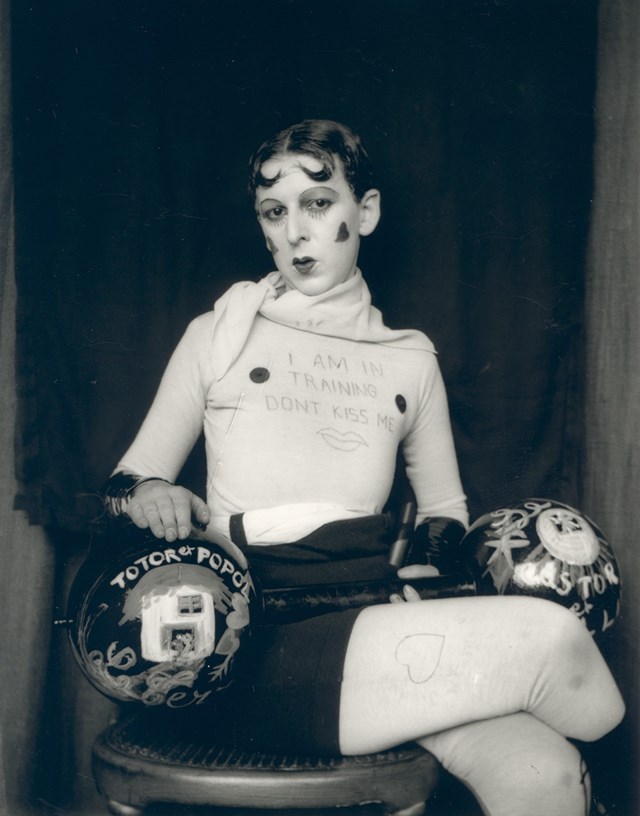
III
‘The body grows outside.’ – Emily Dickinson
The question of transformation, ownership, and re-appropriation is one novelist and cultural theorist Kathy Acker pursued in her work; her greatest invention of all was perhaps herself, ‘deploying…her body in a sort of performative persona.’11
‘Kathy Acker’s body doesn’t belong to her. It isn’t the body of a 50-year-old woman but of an adolescent boy. It isn’t private and hidden, but public property, part of her life’s work, which has been to explore the relationship between the body and language, text and flesh, discourse and skin [..] Her writing on the body extends to a physical marking of her own body; she has shaped it with weights, coloured it with needles and ink and distorted her appearance by piercing her flesh with lumps of metal. She has re-made herself physically just as she has reinvented herself intellectually…’12
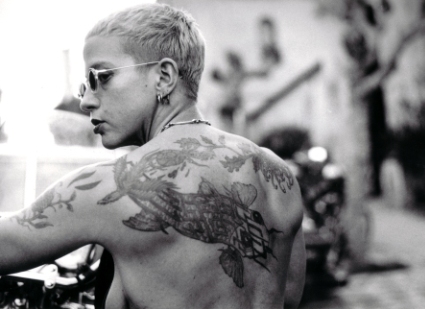
In fact, in ‘Against Ordinary Language: The Language of the Body,’ Acker suggests language and the body are in conflict. Writing on bodybuilding she says: ‘The small loss of language occurs when I journey to and into my own body. Is my body a foreign land to me? What is this picture of ‘my body’ and ‘I’?’
‘If ordinary language or meanings lie outside essence, what is the position of that language game which I have named the language of the body? For bodybuilding (a language of the body) rejects ordinary language and yet itself constitutes a language, a method for understanding and controlling the physical which in this case is also the self. […] By trying to control, to shape, my body through the calculated tools and methods of bodybuilding, and time and again, in following these methods, failing to do so, I am able to meet that which cannot be finally controlled and known: the body. In this meeting lies the fascination, if not the purpose, of bodybuilding. To come face to face with chaos, with my own failure or a form of death.’
IV
‘The sight of blood, the odour of vomit, which arouse in us the dread of death, sometimes introduce us into a nauseous state-which hurts more cruelly than pain.’ – Georges Bataille

Francis Bacon thought the best depiction of the human cry was the still of the blood-soaked nanny from Eisenstein’s Battleship Potemkin. Despite his depictions of horror, crucifixions, disease and mutilations,13 it was the scream, the violence of a sensation, he sought to capture, the ‘glitter’ of the mouth, and in Bacon’s screams ‘the entire body escapes through the mouth.’ He told David Sylvester: ‘I’ve always been very moved by the movements of the mouth and the shape of the mouth and the teeth. People say that these have all sorts of sexual implications, and I was always very obsessed by the actual appearance of the mouth and teeth, and perhaps I have lost that obsession now, but it was a very strong thing at one time. I like, you may say, the glitter and colour that comes from the mouth, and I’ve always hoped in a sense to be able to paint the mouth like Monet painted a sunset.’
Photographs littered the floor of Bacon’s studio in Reese Mews, and, yes, Muybridge’s pictures were there. But, according to Deleuze, what fascinated Bacon was not movement, but its effect on an immobile body. ‘Heads whipped by the wind or deformed by an aspiration, but also all the interior forces that climb through the flesh.14 To make the spasm visible. The entire body becomes plexus. If there is feeling in Bacon, it is not a taste for horror, it is pity, an intense pity: pity for the flesh, including the flesh of dead animals.’
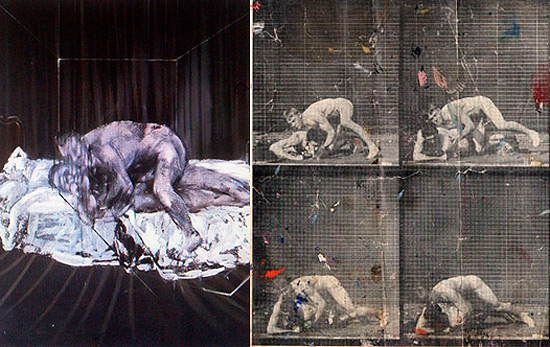
Bacon was fascinated with carcasses, mesmerised in his youth by the local butcher’s shop in County Kildare, and meat and slaughterhouses thread through his work: Carcass of Meat and Bird Prey (1980), Triptych Inspired by TS Eliot’s Poem ‘Sweeney Agnostes’ (1967), Figure With Meat (1954), Painting (1946). ‘We are meat – we are potential carcasses.’ Though we may recoil in horror from death and sexuality, the two were linked in Bacon’s mind, he shared a Bataillean ‘adoration of the base corporeality of the flesh': ‘All the inhabitants of this planet are made of meat. And most of them are carnivores. And when you fuck, it’s a piece of meat penetrating another piece of meat.’15
V
‘If only instead of being a hell, the universe had been an immense anus.’ – Lautréamont
Francis Bacon is a significant influence on ‘living sculptures’ Gilbert and George: ‘What Gilbert and George are excited about and committed to is the message of their work and they cite Francis Bacon whom they state rather categorically, they are nearest to, adding that he didn’t know how to paint, only how to make a powerful image. They also say that his message is a simple one of humanity, fear, unhappiness – three concepts which again they can relate to and always have.’16
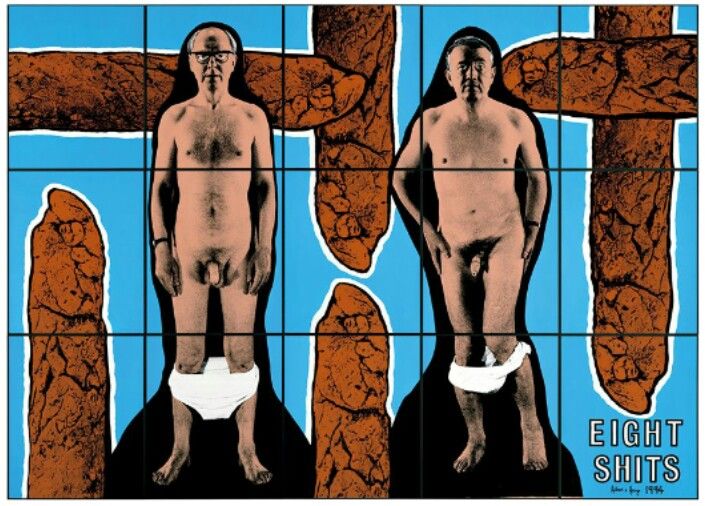
Gilbert and George’s images are powerful. Composed in grids,17 their art is deliberately provocative and harshly critical of society. Challenging taboos in gargantuan works depicting blood, other bodily fluids (labelled with ‘fundamental’ words like ‘piss’, ‘shit’, and ‘spunk’, bodily substances now used in forensic science subsequently) and nudity, Gilbert and George say their art is not intended to be ironic or a joke, but state: ‘We manage to slow down life in our works, to make it more complete. That’s what we try to do: slow life down so you can think about it.’18 David Sylvester commented that while many twentieth-century artists tried to break out of the prettifying conventions of depicting the body as ‘nude’, only Gilbert & George truly succeeded in portraying it as ‘naked’.
Their Naked Shit pictures, as Sylvester said, ‘are a vision of the human race as lost soul, to borrow a phrase I have heard G&G use. They are glimpses of the emptiness of existence after the death of God. G&G are heirs of Beckett as well as Bacon, but more especially of Bacon because despair has a particular force in a body of images where the only acts of love are between males, are therefore acts which partake of a tragic finality. G&G’s art acknowledges this disaster but at the same time grants the consolation that through deep partnership our solitude can be repaired.’
Endnotes
1. Muybridge was acquitted of murder. After the trial, his hair turned white overnight.↩
2. River of Shadows, Eadweard Muybridge and the Technological Wild West (Penguin 2003)↩
3. ‘Eadweard Muybridge: An Eye Over the Abyss,’ Stephen Barber (3:AM Magazine 2012)↩
4. The seriality and repetition of Muybridge’s grids can be seen in the works of Duchamp (Nude Descending a Staircase), Warhol (Marilyns), Sol leWitt, Steven Pippin, and, of course, Francis Bacon.↩
5. Solnit, ibid↩
6. Aveux non avenus, Claude Cahun (1930)↩
7. This Young Monster, Charlie Fox (Fitzcarraldo Editions 2017)↩
8. Moore was more than an assistant, Cahun referred to her as L’Autre Moi, the Other Me, and this creative alliance is explored in Barbara Hammer’s 2006 film, Lover Other.↩
9. Fox, ibid↩
10. Gillian Wearing and Claude Cahun: Behind the Mask, Another Mask, the National Portrait Gallery, London, March-May 2017↩
11. I’m Very Into You, Correspondence 1995-1996, Kathy Acker & McKenzie Wark (Semiotext(e) 2015)↩
12. ‘Written on the Body,’ Independent, 1997↩
13. As Deleuze says in Francis Bacon, the Logic of Sensation (University of Minnesota Press 2005), Bacon’s figures are not ‘racked bodies at all, but ordinary bodies in ordinary situations of constraint and discomfort.’↩
14. What is the difference between flesh and meat? It is worth considering Deleuze on meat in Bacon (viande) against Merleau-Ponty on flesh (chair) in Cézanne, Matisse and Klee.↩
15. Francis Bacon’s Studio, Margarita Cappock (Merrell 2005)↩
16. Gilbert and George, Obsessions and Compulsions, Robin Dutt (Philip Wilson Publishers, 2004)↩
17.’From the very first photo pieces we did, they have always been digital – all those little panels coming together to make forms. The machines can only print out at a certain size, so we keep to that. We love the structure of the grid because we can make compositions.’ Gilbert and George in Lives of the Artists, Lives of the Architects, Hans Ulrich Obrist (Penguin 2016)↩
18. Ibid↩
19. About Modern Art: Critical Essays 1948-96, David Sylvester (Random House 2012)↩
